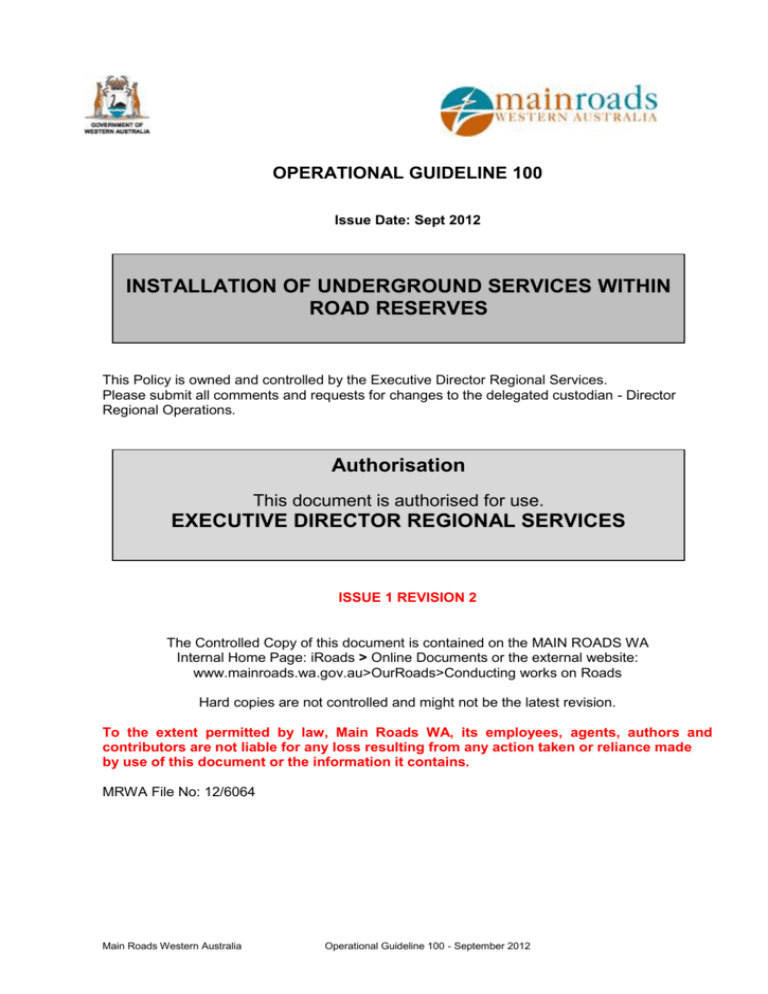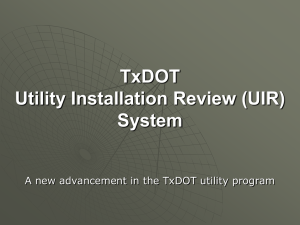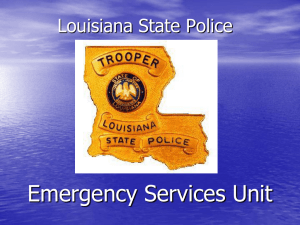OPERATIONAL GUIDELINE No 100 - Main Roads Western Australia
advertisement

OPERATIONAL GUIDELINE 100 Issue Date: Sept 2012 INSTALLATION OF UNDERGROUND SERVICES WITHIN ROAD RESERVES This Policy is owned and controlled by the Executive Director Regional Services. Please submit all comments and requests for changes to the delegated custodian - Director Regional Operations. Authorisation This document is authorised for use. EXECUTIVE DIRECTOR REGIONAL SERVICES ISSUE 1 REVISION 2 The Controlled Copy of this document is contained on the MAIN ROADS WA Internal Home Page: iRoads > Online Documents or the external website: www.mainroads.wa.gov.au>OurRoads>Conducting works on Roads Hard copies are not controlled and might not be the latest revision. To the extent permitted by law, Main Roads WA, its employees, agents, authors and contributors are not liable for any loss resulting from any action taken or reliance made by use of this document or the information it contains. MRWA File No: 12/6064 Main Roads Western Australia Operational Guideline 100 - September 2012 REVISION RECORD ISSUE REVISION DATE CHANGES 1 0 March 2007 Original version 1 1 29.06.2012 Various 1 2 September 2012 Cover Page and other various If you have any questions or comments regarding this document, please contact Peter Sewell, Director Regional Operations, on Ph: (08) 9323 4656; or E-mail: peter.sewell@mainroads.wa.gov.au. Main Roads Western Australia Operational Guideline 100 - September 2012 Page 2 of 9 Contents 1. 2. 3. 4. INTRODUCTION APPROVAL TO INSTALL UNDERGROUND SERVICES TRAFFIC MANAGEMENT INSTALLATION TECHNIQUES 4.1 Trenchless Technology Methods 4.2 Using Existing Conduits or Culverts 4.3 Trench Excavation and Reinstatement 5. SUPERVISION 6. LOCATION OF EXISTING UNDERGROUND SERVICES 7. ADVICE TO BE CONSIDERED FOR UTILITY SERVICE PROVIDERS 7.1 Utilities and Fixtures 7.2 Protection of Flora and Fauna 7.3 Hygiene Control for Die-Back 8. INSTALLATION AND REINSTATEMENT 8.1 General 8.2 Site Preparation 8.3 Clearing 8.4 Trench Cutting 8.5 Removal Procedures 8.6 Excavation and Installation Main Roads Western Australia Operational Guideline 100 - September 2012 4 4 5 5 5 6 6 6 7 7 7 7 7 8 8 8 8 9 9 9 Page 3 of 9 1. INTRODUCTION (This document is a Main Roads WA (MRWA) Guideline for the information of its staff. It is shown on the MRWA external website for transparency and ease of access, however it is not a specification or a standard, and its use is not mandatory. It is basically background information and an aid for understanding and applying MRWA requirements for installation of underground services in road reserves). Main Roads policies for works in its road reserve is shown in the document “Utility Services in Road Reserves – Policy and Guidelines” (located on its external website in under “Our Roads > Conducting Works on Roads). Underground services include buried pipes and cables owned by Utility Service Providers and by other Organisations and individuals. In general, Utility Service Providers are organisations such as Western Power, Alinta, Telstra, Water Corporation and private organisations such as SingTel Optus Pty Ltd and Epic Energy that will need to install underground services within MRWA road reserves. However, these guidelines also relate to those organisations other than Utility Service Providers that are planning to install underground services within MRWA road reserves. For installing underground services, refer to the ‘Utility Providers Code of Practice for Western Australia’, managed by the Utility Providers Services Committee. Note: (a) All references to specific documents are current editions of these documents. (b) All references to Utility Service Provider also include its nominated Contractor. 2. APPROVAL TO INSTALL UNDERGROUND SERVICES Under the Main Roads Act (1930), the Commissioner of Main Roads is responsible for the care, control and management of the land over which a highway or main road is declared. The ‘Utility Providers Code of Practice for WA’ outlines the allocation of space for utility services within the road reserve, particularly the Metropolitan area and built-up Regional areas, including the minimum standard cover for underground services. If required, Utility Service Providers are to undertake reinstatement works (both pavement and verge) in accordance with standards set by the road authority. Any individual, Organisation or Utility Service Provider that intends to carry out the installation of underground services within the road reserve or beneath the road pavement of a highway or main road must seek approval from MRWA prior to undertaking the works. This is necessary so that MRWA can advise and obtain agreement on matters relating to public safety, traffic management and reinstatement requirements. Applicants must use one of the following corporate documents as appropriate to obtain the required approval: Application Form for Utility Service Providers & Local Governments to Undertake Works Within Road Reserves Managed by Main Roads WA (Document No 15/01/11) Application Kit and Guidelines for Organisations Seeking to Undertake Works Within the Road Reserve – Complex Works (Document No 16/02/12) Application Kit and Guidelines for Organisations Seeking to Undertake Works Within the Road Reserve – Non Complexity Works (Document No 16/02/12A) Specifications to be used during installation and reinstatement of utility services are to be agreed between MRWA and the Utility Provider prior to the commencement of the works Main Roads Western Australia Operational Guideline 100 - September 2012 Page 4 of 9 3. TRAFFIC MANAGEMENT The Utility Service Provider is responsible for the preparation and implementation of Traffic Management Plans at the roadworks site to provide a safe environment for road workers and road users. Traffic Management Plans at the Roadworks site shall be in accordance with: AS 1742.3 –’Traffic Control Devices for Works on Roads’ and its associated Field Guides Main Roads WA ’Traffic Management for Works on Roads Code of Practice’ The Utility Service Provider is required to submit a Traffic Management Plan at least two weeks prior to the commencement of any works. MRWA needs to sight the Traffic Management Plan prior to commencement of works to ensure the proposed plans do not adversely impact on the efficiency of the road. It is possible to have several traffic management concepts that will provide adequate safety to the road worker as well as to the road user, however, it is likely that only one or two of these concepts can provide an acceptable level of service and convenience to the road user. Where the Traffic Management Plan proposed by the Utility Service Provider is likely to adversely impact upon road users, they must be asked to amend or prepare another Plan that allows for the most efficient use of the road based on its known usage requirements. MRWA staff should not approve or endorse the Traffic Management Plan. It is the responsibility of the accredited person preparing the Traffic Management Plan to ensure the Plan provides for the safety of the road worker and of the road user. However, MRWA staff may need to advise the Utility Service Provider of the level of service required while the works are being undertaken. The Traffic Management Plan should be based on these requirements. 4. INSTALLATION TECHNIQUES The following options are available where it is necessary to place underground services beneath the road pavement: Trenchless technology methods Utilise existing conduits / culverts Trench excavation and reinstatement Where underground services are to be placed beneath the road and any existing conduits or culverts cannot be used, preference should be given to the use of trenchless technology methods. Refer to ‘Guidelines for Installation of Services under Existing Pavement’, Pavements Engineering Report No 2004-21M (D Cheema). 4.1 Trenchless Technology Methods There are numerous methods available for the installation of underground services without the need to excavate a trench. The use of trenchless technology methods is of particular benefit in the Metropolitan area and Regional built-up areas but should also be considered in Regional non–built up areas. Trenchless technology methods include the following: Auger Boring Slurry Boring Micro-tunnelling Horizontal Directional Drilling Pipe Ramming Main Roads Western Australia Operational Guideline 100 - September 2012 Page 5 of 9 Pipe Jacking Thrust Boring There is no single trenchless technology method that is best for all types of crossings. Site conditions and constraints as well as the purpose of the crossing must be considered when a method is selected. Presently there is no Australian Standard for the use of trenchless technology methods. The Australian Society for Trenchless Technology expects to develop an Australian Standard some time in the future. Many Utility Service Providers such as Western Power, Alinta, Telstra and Water Corporation have considerable experience in the use of trenchless technology methods and normally use competent Contractors to perform this function. Contractors available for installation by trenchless technology methods usually have properly trained staff and have effective and appropriate Specifications and Guidelines. Note: The Utility Service Provider or owner of the utility service is responsible for the design, construction and liability of the utility service installation. 4.2 Using Existing Conduits or Culverts Where services can be installed in existing conduits or culverts, the appropriate approval must be obtained from MRWA prior to any installation being undertaken. Generally culverts should not be used for permanent installations as these interfere with water flow. Culverts should only be used for temporary situations where there is little risk to the road integrity. 4.3 Trench Excavation and Reinstatement Where it becomes necessary to install a service beneath an existing pavement, it is generally more cost effective initially to install the service by cutting a trench and reinstating it. However, it is also necessary to consider the impacts that this might have on the following: The life of the pavement The effect on business Traffic disruption The probability of crashes The environment Based on a total life cycle, the cost of trenchless technology methods can often be less than that for trench excavation and reinstatement. Note: In the case of trench excavation and reinstatement, an appropriate ‘defects liability period’ is to be applied to the reinstated work and defined in the Application approval by MRWA. 5. SUPERVISION It will normally be necessary to apply a significant amount of supervision to work that is being undertaken by trench excavation and reinstatement. To minimise the amount of settlement that occurs after the works have been completed, it is necessary to consider the type of material Main Roads Western Australia Operational Guideline 100 - September 2012 Page 6 of 9 being used for backfill and the pavement layers as well as the degree of compaction achieved. Sufficient resources need to be allocated to ensure appropriate work practices are being used and that the Utility Service Provider is meeting the requirements of the Reinstatement Specification. 6. LOCATION OF EXISTING UNDERGROUND SERVICES Before undertaking the installation of any underground service within the road reserve, it is essential to determine the location of any existing underground service that may be in the proximity of the proposed works. Dial Before You Dig, as detailed in the ’Utility Providers Code of Practice for WA’, can be used to establish the location of existing buried services in both Metropolitan and Regional areas. For work in Regional areas it may also be necessary to contact relevant Utility Service Providers and other Organisations prior to commencing work. It is the responsibility of the individual, Organisation or Utility Service Provider intending to install services to ensure that they obtain this information. 7. ADVICE TO BE CONSIDERED FOR UTILITY SERVICE PROVIDERS 7.1 Utilities and Fixtures Permanent road signs (eg advisory, regulatory, warning, etc) that obstruct operations are to be removed and stored. Any sign removed must be replaced at the completion of the works or when directed by MRWA. Approval by MRWA must be obtained prior to the removal of any road sign. Any sign damaged by the Utility Service Provider or its agents will be replaced at their cost. The Utility Service Provider shall take all special precautions when using vibratory equipment in the vicinity of buildings or dams. The use of vibratory rollers or similar plant in vibrating mode will not be permitted within 30m of any building or dam. Any damage caused by the Utility Service Provider shall be rectified immediately at their cost. MRWA may arrange to rectify the damage and claim costs for repairs from the Utility Service Provider. The Utility Service Provider shall not obstruct any access(es) to property, roadside material stockpile/dump site or water supply, including dams and standpipes. 7.2 Protection of Flora and Fauna The Utility Service Provider shall comply with the provisions of the applicable legislations and exercise care during the course of the works to avoid unnecessary destruction of native flora and fauna. The location of known sites of rare flora will be provided to the Utility Service Provider by MRWA who will advise of protection measures to be undertaken. The Utility Service Provider must advise MRWA of suspected sites of rare flora found during the course of the works. 7.3 Hygiene Control for Die-Back Die-back hygiene procedures will be strictly enforced in areas which are die-back free. The Utility Service Provider shall comply with MRWA and DEC procedures in these areas. Main Roads Western Australia Operational Guideline 100 - September 2012 Page 7 of 9 8. INSTALLATION AND REINSTATEMENT 8.1 General Generally it will be necessary to reinstate excavations with materials equivalent to the adjacent undisturbed insitu condition, to the satisfaction of MRWA and in accordance with agreed Specification (refer to Section 2 above). Unless otherwise specified by MRWA, the minimum standard cover of underground services within the road reserve shall be in accordance with the requirements specified in the ‘Utility Providers Code of Practice for WA’. In Freeways, Controlled Access Roads and roads in non-built up Regional areas, no manhole(s), valve(s) or other utility service structure are to be installed within the road reserve unless an Agreement with MRWA has been obtained to install a utility service in these road reserves. Regarding other roads, including built-up Regional areas, prior notification and approval of proposed location of utility services must be obtained from MRWA. No manhole(s), valve(s) or other surface mounted structures located within the road pavement are to be installed directly beneath the ‘wheel path’ of road users. 8.2 Site Preparation The Utility Service Provider shall determine the location and protect any existing utility services within the road reserve prior to commencing work in accordance with the ‘Utility Providers Code of Practice for WA’. Prior to the commencement of the Works, road markings likely to be removed during the works, shall be referenced for subsequent reinstatement. Concrete paths and kerbs that will interfere or be disturbed by the works shall be removed to an appropriate joint and replaced at the completion of the works. 8.3 Clearing Where the clearing of native vegetation is proposed, it is likely that a ‘clearing permit’ will be required from the Department of Environment and Conservation. Note: The Permit process can take several months to complete. No significant vegetation within the road reserve shall be removed prior to approval by MRWA. The Utility Service Provider shall clear all areas designated for excavation, taking particular care to preserve any vegetation adjacent to the work area. Where the works are off-road, 150mm of topsoil shall be stripped and stockpiled prior to excavation; and respread over the compacted fill at the completion of the works. Where the works are on-road, the shoulder/verge areas are to be restored to the same condition as the adjacent undisturbed area or as directed by MRWA. Trees and other significant vegetative material shall be removed to approved dump site(s) or disposed of for wood craft use and are not to be stockpiled on site or any areas visible to the public. Mulching of vegetative material should be considered. Any areas prone to erosion that are disturbed by the Utility Service Provider, shall be stabilised, mulched and revegetated. Main Roads Western Australia Operational Guideline 100 - September 2012 Page 8 of 9 8.4 Trench Cutting All trenches shall be of sufficient width to ensure appropriate compaction equipment can be used to achieve required compaction densities. The line of cut for each side of the trench shall be marked prior to excavation. Saw cutting is the preferred method of delineating the area to be removed. The depth of cut shall be set at no less than minimum required to ensure the pavement and surfacing adjacent to the edge of the trench does not crack, fret or crumble in subsequent operations. A mechanical spade or similar device may be used for thin seal coats, provided it is demonstrated that the cut face of the pavement layers is not damaged. If necessary, the cut face in the base course and the surfacing layers should be set back 150mm from the lip of the trench to ensure better support for the remaining pavement. 8.5 Removal Procedures Asphalt or other bituminous layers shall be removed and disposed at a designated site. The excavation shall be carried out such that the cut edges of the retained seal and the wall of the excavation shall be free of tears, jagged edges or undercutting of the retained material. The sides of the cut shall be vertical. There shall be no separation of the retained seal from its base material. The use of explosives to excavate rock shall only be used in consultation with MRWA and in accordance with applicable legislation. Where explosives are to be used in close proximity to buildings and other structures, a survey of these facilities by a suitably qualified assessor must be made prior to the use of explosives. The relevant Local Government and Statutory Authority must be notified of proposed use of explosives and all operations shall comply with AS 2187 – ‘Use of Explosives’. 8.6 Excavation and Installation Excavation works (inclusive of open pits required to achieve trench-less installation) shall not encroach closer than 3m to a bridge or building structure and shall not encroach into the nominated stand-off distance (3 x depth of excavation + 0.5m) to the edge of the bitumen/kerb or load bearing surface. All other entry and exit points shall be located at a minimum offset distance of 1.0m clear of the bitumen/kerb or load bearing surface. For excavation/trenching works undertaken inside the nominal stand-off distance, an independent Geotechnical Engineer’s report must be submitted to MRWA, as a supplement to the Application, to ensure the trench stability. A lateral clearance of 0.5m is to be maintained at all times to all MRWA underground assets (ie piped drainage, electrical conduits, etc). Adequate shoring or sheet piling approved by MRWA shall be used where the trench is within (2.0m + trench depth) from a building or a load bearing structure or as requested by MRWA. All proposed utility services to be installed under the road pavement (eg pipes, conduits, cables, etc) shall be approved by MRWA prior to the commencement of the works and be located perpendicular to the road centre-line where practicable. In the case of utility services designed to carry fluids or gas (carrier pipes) under pressure, relevant industry standards must be used to minimise risks of carrier pipe failure and associated damage. Stop valves will be required to be installed immediately upstream of all fluid or gas utility services reticulation systems located in the road reserves. MRWA is to be advised by the Utility Service Provider of the requirements for trunk mains or distribution systems. Main Roads Western Australia Operational Guideline 100 - September 2012 Page 9 of 9








